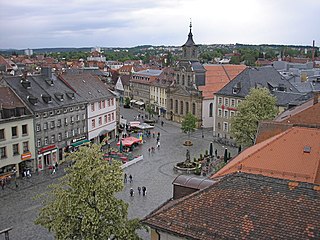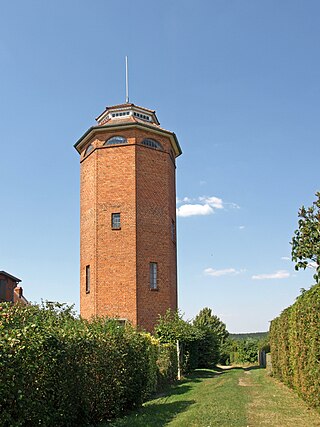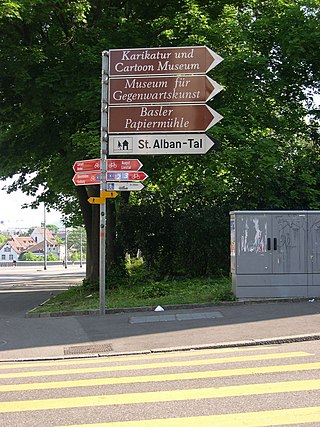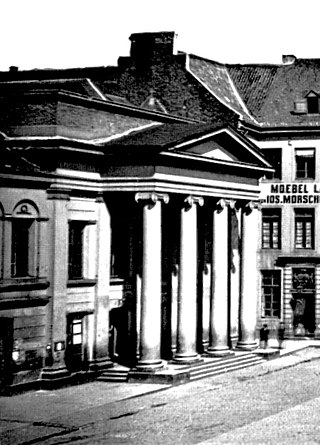
Bayreuth is a town in northern Bavaria, Germany, on the Red Main river in a valley between the Franconian Jura and the Fichtel Mountains. The town's roots date back to 1194. In the 21st century, it is the capital of Upper Franconia and has a population of 72,148 (2015). It hosts the annual Bayreuth Festival, at which performances of operas by the 19th-century German composer Richard Wagner are presented.

Celle is a town and capital of the district of Celle in Lower Saxony, in north-central Germany. The town is situated on the banks of the river Aller, a tributary of the Weser, and has a population of about 71,000. Celle is the southern gateway to the Lüneburg Heath, has a castle built in the Renaissance and Baroque styles and a picturesque old town centre with more than 400 timber-framed houses, making Celle one of the most remarkable members of the German Timber-Frame Road. From 1378 to 1705 Celle was the official residence of the Lüneburg branch of the dukes of Brunswick-Lüneburg, who had been banished from their original ducal seat by its townsfolk.

Rosenheim is a city in Bavaria, Germany. It is an independent city located in the centre of the district of Rosenheim, and is also the seat of its administration. It is located on the west bank of the Inn at the confluence of the rivers Inn and Mangfall, in the Bavarian Alpine Foreland. It is the third largest city in Upper Bavaria with over 63,000 inhabitants. Rosenheim is the economic centre and the busiest place in the region.

Meiningen is a town in the southern part of the state of Thuringia, Germany. It is located in the region of Franconia and has a population of around 26,000 (2024). Meiningen is the capital and the largest town of the Schmalkalden-Meiningen district. From 1680 to 1920, Meiningen was the capital of the Duchy of Saxe-Meiningen.

The Kunstpalast, formerly Kunstmuseum Düsseldorf is an art museum in Düsseldorf.

The ARoS Aarhus Kunstmuseum is an art museum in Aarhus, Denmark. The museum was established in 1859 and is the oldest public art museum in Denmark outside Copenhagen. On 7 April 2004, ARoS Aarhus Kunstmuseum opened with exhibitions in a brand new modern building, 10 stories tall with a total floor area of 20,700 m² and designed by Danish architects Schmidt Hammer Lassen. Today, ARoS is one of the largest art museums in Northern Europe with a total of 980,909 visitors in 2017.

Vienna City Hall is the seat of local government of Vienna, located on the Rathausplatz in the Innere Stadt district. Constructed from 1872 to 1883 in a neo-Gothic style according to plans designed by Friedrich von Schmidt, it houses the office of the Mayor of Vienna, as well as the chambers of the city council and Vienna Landtag diet.

Laage is a town in Rostock (district) in Mecklenburg-Vorpommern (Germany). It is situated on the river Recknitz, 23 kilometers southeast of Rostock.

The Kunstmuseum Basel houses the oldest public art collection in the world and is generally considered to be the most important museum of art in Switzerland. It is listed as a Swiss heritage site of national significance.

The Junkerngasse is a street in the Old City of Bern, the medieval city center of Bern, Switzerland. It connects the tip of the Aar peninsula to the Münster.

The Basel museums encompass a series of museums in the city of Basel, Switzerland, and the neighboring region. They represent a broad spectrum of collections with a marked concentration in the fine arts and house numerous holdings of international significance. With at least three dozen institutions, not including the local history collections in the surrounding communities, the region offers an extraordinarily high density of museums compared to other metropolitan areas of similar size. They draw some one and a half million visitors annually.
Helmut Federle is a Swiss painter.

Altes Theater was a theatre in Düsseldorf, North Rhine-Westphalia, Germany. It operated between 1747 and the early 1870s, when it was replaced by the Stadttheater Düsseldorf.

Diet Sayler is a German painter and sculptor.

Quaianalagen or Seeuferanlagen on Lake Zürich is a series of lakefronts in Zürich. Inaugurated in 1887, the quaysides are considered an important milestone in the development of Zürich. The construction of the lake fronts transformed the medieval small town on the rivers Limmat and Sihl to a modern city on the Lake Zürich shore. The project was managed by engineer Arnold Bürkli.
Caspar Walter Rauh was a German graphic artist, illustrator and painter during the post-war period. He was part of the art movement known as Fantastic Realism.
Adolf Falke was a German architect, draughtsman, designer, stage designer and municipal politician.
Hans Wilhelm Hupp (1896–1943) was a German art historian, author and curator. From 1933 to 1943 he directed the Museum Kunstpalast of the city of Düsseldorf..

Sankt Georgen is an 18th-century planned new town, today a district of the city of Bayreuth in Bavaria.
Miron Schmückle is a German-Romanian artist, stage designer and cultural researcher. He lives and works as a freelance artist in Berlin (Germany) since 2008.

















